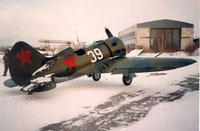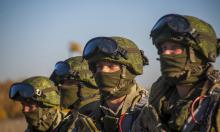Soviet Union Launched Its Arms Export in 1921
Low price, high performance, simplicity and reliability – these are the basic qualities that determine the export potential of arms. It is generally believed that Russian arms meet the needs of “poor” countries. However, the history of Russian arms export speaks of the opposite. The Russian defense complex regularly wins competition with widely advertised and hailed Western armory.

It all started long before the creation of the socialist camp and the collapse of the colonial system. The Soviet Union began to export its arms in 1921. That was the time when military hardware could not be shipped abroad on board vessels and cargo planes. It was transported by land on horses, camels and even elephants. The first country, which imported Soviet-made arms, was Afghanistan. The USSR shipped there over 20 planes, presumably P-1 reconnaissance aircraft, which was a developed version of the DH-9 aircraft designed by Britain’s DeHavilland.
The USSR supplied Afghanistan with several British prototypes of P-1. The DH-9, seized during the intervention, then belonged to the Air Force of the Red Army. Afghanistan preferred the Soviet analogues of the DeHavillands. That was the first, albeit indirect, victory of the Soviet aviation technology on the international market.
However, in this particular case it goes about the military support to the country, which was the first to acknowledge the new Soviet nation. It was not a commercial export of arms . In the beginning of the 1920s, Afghanistan received about 30 aircraft from the RSFR and the USSR. Soviet pilots soon established the first flight school in Afghanistan.
One may say that Afghanistan became a lab mouse for the USSR’s defense complex. The Soviet Union exercised various methods of shipments, including untraditional ones, the supply of spare parts and the training of local pilots. The deal covered nearly everything what currently constitutes successful business in conquering the arms market.
The P-1 aircraft had a rich biography. The aircraft was actively used in tribal clashes in Afghanistan. The plane quickly became popular in other countries, which had a lot to do for the development of their national air forces.
The second generation of the P-1 in the Middle East fully complied with the notion of ‘export.’ Two aircraft of this type were exported to Persia (Iran) in May 1924. The Persians liked the Soviet planes and ordered six more during the same year. They purchased some more during the next two years. Afterwards, Persia acquired 20 aircraft from the USSR including I-2 fighter jets, U-1 training panes and P-1 drones. Twelve more planes were shipped to Persia from the Soviet Union from 1929 to 1930.
The USSR’s first-ever experience in international arms competitions took place in Persia too. On September 4, 1930 a group of new P-5 planes performed a flight on the route Moscow-Sevastopol-Ankara-Tbilisi-Teheran-Termez-Kabul-Tashkent-Orenburg-Moscow. It was possible to perform a similar test flight (10,500 kilometers) inside the USSR. Therewas no need to fly to Turkey, Persia and Afghanistan.
The intention of such an adventure was obvious: the Soviet Union tried to attract potential customers to the new aircraft. As a result, the nation prepared three reconnaissance aircraft for defense aviation competition in Persia. The country had serious competitors – France, England and Holland.
It is worthy of note that the Soviet plane won the competitive struggle in May 1931 on its flight characteristics, but lost in terms of politics and economics. A Persian Shah preferred to turn to the West. The defense cooperation with Persia and then Iran was suspended for many years afterwards.
The P-5 was eventually sold to China. In 1933, the Soviet Union signed a series of commercial agreements with China’s Xinjiang Province. The appearance of P-5 planes piloted by Soviet pilots to suppress anti-governmental mutinies produced an astounding effect on protesters. As a result, there was no need to use weapons against them.
The P-5 was not the first Soviet plane that found itself in China. In the middle of the 1920s the USSR sent about 30 P-1 planes to the province of Guandong.
The USSR was delivering its aviation to other countries mostly free of charge within the scope of defense programs to support brotherly nations.
The brightest victory of the domestic aviation industry was celebrated after the agreement to produce the Soviet SB bomber in Czechoslovakia. The production license became possible in spite of the fact that this country could boast of having a strong aviation industry.
The high-speed SB bomber became the first domestic aircraft the production of which was launched abroad. On May 16, 1935 Prague and Moscow signed a mutual defense assistance agreement. Czechoslovakia sold a Skoda mountain gun production license to the Soviet Union, whereas the USSR granted the European nation a right for the production of 160 SB bombers.
The bombers assembled in Czechoslovakia were called Avia B.71. Afterwards, the USSR sold 80 planes of this type to the nation, although the Czechoslovaks broke 17 planes during the transportation.
Many years later, the SB bombers assembled in Czechoslovakia served in Luftwaffe and in defense aviation of the allies of Nazi Germany. However, this is a completely different story.
The Soviet Union also established the production of its planes in China during the pre-war period. However, the USSR had to face a problem which was very typical of the Chinese defense industry – illegal copying. Nevertheless, the USSR shipped T-26 tanks, small arms, artillery, SB bombers and fighter jets to China during the time when China came into an armed conflict with Japan.
The Chinese later decided to design their own version of the Soviet I-16 fighter jet. They illegally used the Soviet technology to assemble nearly 30 jets, although they originally planned to build almost 300 aircraft.
Sergey Nikolayev
Pravda.Ru
Subscribe to Pravda.Ru Telegram channel, Facebook, RSS!


